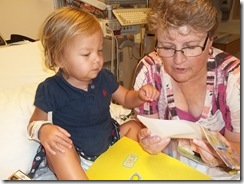The good news is that Tiptoe is in less pain than she was last week. M and I both have  noted how happy she is (when she’s happy). She seems fairly comfortable and is engaging and playing with us as normal. We spent a lot of the weekend playing with her bunny puppet and her Mickey Mouse doll; M got her a big balloon and the bunny would grab it and haul it down for Mickey and him to bounce on, trampoline-like. Then Tiptoe would push it away and squeal as it floated up to the ceiling. Repeat ad infinitem.
noted how happy she is (when she’s happy). She seems fairly comfortable and is engaging and playing with us as normal. We spent a lot of the weekend playing with her bunny puppet and her Mickey Mouse doll; M got her a big balloon and the bunny would grab it and haul it down for Mickey and him to bounce on, trampoline-like. Then Tiptoe would push it away and squeal as it floated up to the ceiling. Repeat ad infinitem.
Also: she’s in love with stickers. Her grandmother (above) brought her a couple ziploc bags full of them and a big package of construction paper. Tiptoe was not happy with the rationing that I had to enforce after she burned through one whole bag in a single hour…
We had the same nurse over the long holiday weekend so we were able to set up a schedule that suited Tiptoe’s needs, in terms of getting her medicines and vitals and so on. We worked it out so that instead of coming in at 10pm to do vital signs (weight, blood pressure, temp) they came in before bedtime. We got her medicines scheduled to allow her to get 6 hours of uninterrupted rest, and eventually took her off motrin so that she could try to sleep through the night (not quite successful with that one…).
Of course, last night she got a new nurse who apparently wasn’t kosher on the schedule we’d configured.
While most of that is good news—and believe me, we’re appreciative of it—the problem with drainage is ongoing and not really improving. Here’s what’s happening, as I understand it:
After trauma to the heart (such as open heart surgery), fluid begins to collect in the sacs that surround the lungs. If not dealt with, the fluid begins to press against the lungs, making breathing difficult. Since breathing is labored, the lungs can’t get oxygen to the blood stream as effectively. Without an adequate supply of oxygen, the body starts to fail. Two methods are used to dispose of this fluid: 1) Chest tubes are inserted through the chest into the sacs to allow them to drain; 2) patients are given diuretic medicines (lasix) to help them pee and get rid of the fluid naturally. When the fluid from the chest tubes gets down to a manageable level (for her Norwood operation, “manageable” meant less than 40 mL/day, I think), the chest tubes are removed and the holes are allowed to close. Patients are kept for a period of 24-48 hours to make sure that the body is able to cope with the fluid on its own, or with the assistance of lasix.
The first time Tiptoe had a heart surgery, they took out the chest tubes too early. Her lungs began to fail a day or so later , and they had to reinsert them, which no one was happy about. We don’t want that to happen again.
The output from the chest tubes is hovering around the 200-300 mark. The surgeon has  said that if it can get down below 100, they’ll start evaluating when it’s time to take the chest tubes out. Until then, it’s just a waiting game. There’s no rhyme or reason to who puts out more fluid; it’s apparently something every cardiothoracic physician/surgeon looks at and studies, but no one has drawn any provable, replicable conclusions for how to improve the situation.
said that if it can get down below 100, they’ll start evaluating when it’s time to take the chest tubes out. Until then, it’s just a waiting game. There’s no rhyme or reason to who puts out more fluid; it’s apparently something every cardiothoracic physician/surgeon looks at and studies, but no one has drawn any provable, replicable conclusions for how to improve the situation.
Other than time, I mean. Time heals all wounds, or whatever.
